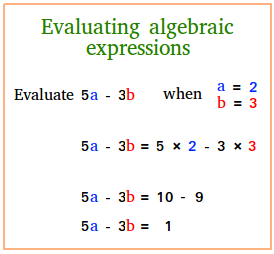Evaluate algebraic expressions
What are algebraic expressions? How do we evaluate algebraic expressions? Are there any real-life applications? These questions will be answered in this lesson.
What are algebraic expressions?
When mathematical expressions use only real numbers, we call these expressions numerical expressions. Algebraic expressions, also called variable expressions, are expressions that contain numbers, operation symbols, and one or more variables. Keep in mind that algebraic expressions never have equal signs!
Below see some examples of algebraic expressions. Notice that the last two expression are radicals. We will also show how we can evaluate them in the next section. The last section will show you some real-life applications.
- 2a + b + 1
- a + 4b - ab
- a + 4a ÷ b - 3b
- x3 + y2
- 3x2 - 4x + 2
- xy + 2yz + 5
- √(yz - 10)
- √(x2 + 3)
How to evaluate algebraic expressions?
You can evaluate algebraic expressions when you substitute numbers for the variables in the algebraic expressions and then follow the order of operations. For example, in the figure below, notice the given value of each variable, also called "assigned value".

As you can see, a has the given number or value 2 and b has the given value 3. Just replace these given values in the algebraic expression and then follow the order of operations.
More examples showing how to evaluate algebraic expressions without exponents
Example #1
Evaluate the following expression for a = 3 and b = 5
2a + b + 1
Substitute 3 for a and 5 for b
2a + b + 1 = 2 × 3 + 5 + 1
First, multiply 2 and 3
2a + b + 1 = 6 + 5 + 1
Add from left to right starting with 6 and 5
2a + b + 1 = 11 + 1
Finally, add 11 and 1
2a + b + 1 = 12
The variables in an algebraic expression can be assigned different values. Notice that if you wish, you could change the value of either a, b, or the value of both a and b. In this case, the value of the expression changes as well!
Example #2
Evaluate the following expression for a = 2 and b = -1
a + 4b - ab
Substitute 2 for a and -1 for b
a + 4b - ab = 2 + 4(-1) - (2)(-1)
First, multiply 4 and -1 and also 2 and -1
a + 4b - ab = 2 + -4 - (-2)
Add the opposite when subtracting
a + 4b - ab = 2 + -4 + 2
Add from left to right starting with 2 and -4
a + 4b - ab = -2 + 2
Finally, add -2 and 2
a + 4b - ab = 0
Example #3
Evaluate a + 4a ÷ b - 3b for a = 5 and b = -4
Substitute 5 for a and -4 for b
a + 4a ÷ b - 3b = 5 + 4(5) ÷ -4 - 3(-4)
First, multiply 4 and 5 and also 3 and -4
a + 4a ÷ b - 3b = 5 + 20 ÷ -4 - -12
Divide 20 by -4
a + 4a ÷ b - 3b = 5 + -5 - -12
Add the opposite when subtracting
a + 4a ÷ b - 3b = 5 + -5 + +12
Add from left to right starting with 5 and -5
a + 4a ÷ b - 3b = 0 + +12
Add 0 and +12
a + 4a ÷ b - 3b = 12
Example #4
Evaluate xy + 2yz + 5 for x = 2, y = -3, and z = 4
Substitute 2 for x, -3 for y, and 4 for z
xy + 2yz + 5 = (2)(-3) + 2(-3)(4) + 5
First, multiply 2 and -3 and also -3 and 4
xy + 2yz + 5 = -6 + 2(-12) + 5
Multiply 2 and -12
xy + 2yz + 5 = -6 + -24 + 5
Add or subtract from left to right starting with -6 and -24
xy + 2yz + 5 = -30 + 5
xy + 2yz + 5 = -25
A couple of examples showing how to evaluate algebraic expressions with exponents
Example #5
Evaluate x3 + y2 for x = 2 and y = 2
x3 + y2 = (2)3 + (2)2
Evaluate the exponents
x3 + y2 = 8 + 4
Add 8 and 4
x3 + y2 = 12
Example #6
Evaluate 3x2 - 4x + 2 for x = 4
3x2 - 4x + 2 = 3(4)2 - 4(4) + 2
First, evaluate the exponent
3x2 - 4x + 2 = 3(16) - 4(4) + 2
Perform the multiplications by multiplying 3 and 16 and also 4 and 4.
3x2 - 4x + 2 = 48 - 16 + 2
Add or subtract from left to right starting with 48 and 16
3x2 - 4x + 2 = 32 + 2
Add 32 and 2
3x2 - 4x + 2 = 34
Evaluating algebraic expressions with real life examples
Example #7
The expression 16t2 models the distance in feet that an object falls during t seconds after being dropped from a certain distance. Find the distance an object falls after 10 seconds.
The given expression above has only one variable. You just need to evaluate 16t2 for t = 10
16t2 = 16 × t × t
16t2 = 16 × 10 × 10
Multiply from left to right starting with 16 and 10
16t2 = 160 × 10
Multiply 160 and 10
16t2 = 1600
The distance the object fell is 1600 feet
Example #8
Richard owns x cars and y trucks. James owns four less cars than Richard, but twice as many trucks. Write an algebraic expression showing the number of vehicles James owns. If Richard owns 6 cars and 2 trucks, how many vehicle does James own?
James owns four less cars than Richard or x - 4
James owns twice as many trucks as Richard or 2y
The number of vehicles James owns is x - 4 + 2y
To find out how many vehicles James owns, we need to evaluate the algebraic expression x - 4 + 2y for x = 6 and y = 2.
x - 4 + 2y = 6 - 4 + 2 × 2
First, multiply 2 and 2
x - 4 + 2y = 6 - 4 + 4
Add or subtract from left to right starting with 6 and 4
x - 4 + 2y = 2 + 4
At this point, you can say that James owns 2 cars and 4 trucks. But you are looking for the number of vehicles he owns.
So, add 2 and 4
x - 4 + 2y = 6
The number of vehicles James owns is 6
